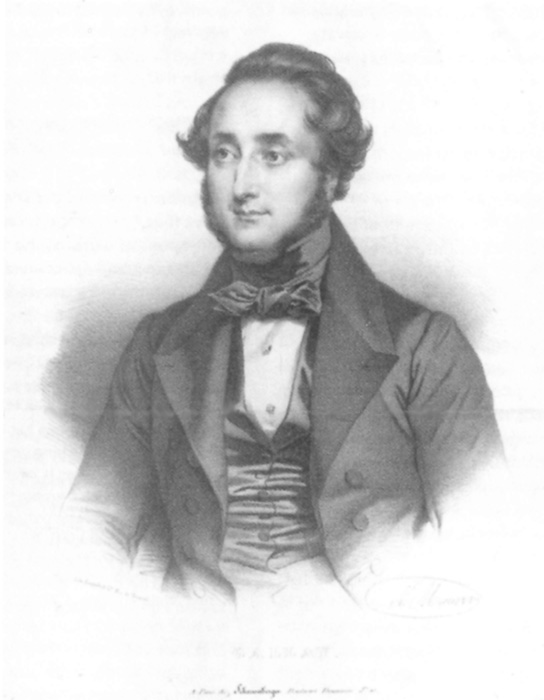Jacques-François Gallay
Music for Natural Horn(s)
Media Review / Listening Diary 2014-11-23
2014-11-23 — Original posting
2016-07-28 — Brushed up for better readability
Table of Contents
Introduction
Anneke Scott first caught my attention through her CD with horn sonatas by Beethoven, Krufft, and Leidesdorf / Bellonci that she produced in 2011. On that CD, she is playing natural horn (what else?) together with Kathryn Cok on the fortepiano. It’s a lovely recording that I really like! So, I was happy to participate in the crowdfunding campaign that Anneke started for the support of her recording projects featuring music by Jacques-François Gallay (1795 – 1864). Gallay was a famous French horn player at his time: I have taken the freedom to reproduce the picture below from the CD booklet:

© Universitätsbibliothek Frankfurt/Main [S36_G04034])
Jacques-François Gallay
There is more than anecdotal evidence for this musician: Gallay has left behind a body of compositions for his instrument, the natural horn. In this context, the term “natural horn” stands for more than the instrument that gained popularity through the 18th century: it’s an instrument that had developed from the hunting horn. The latter was limited to the natural harmonics. Particularly in France, hornists developed a technique called the hand horn. With this, a hand in the cone of the instrument modulates the tone, the pitch, giving access to a much wider range of tones, beyond the natural harmonics (see my earlier post for references to YouTube videos where Anneke explains her art).
In France, this technique prevailed up till around the middle of the 19th century, until finally the horns with valves (which essentially are in use up to this day) took over. Anneke Scott is a real master in playing the natural (hand) horn — a fairly rare species these days! Anneke plays a historic natural horn, a “cor solo“, built by Marcel-Auguste Raoux, in 1823. The “cor solo” is a horn with crooks that are placed inside the main circle. This differentiates it from the cor d’orchestre, where crooks are be added between the mouthpiece and the instrument body.
Préludes, Caprices, and Fantaisies for Horn Solo
Jacques-François Gallay: Concerts Cachés (Préludes, Caprices, Fantaisies)
Anneke Scott, natural horn (cor solo by Marcel-Auguste Roux, 1823)
Resonus, ASCD01 (CD, stereo); ℗ / © 2012
Booklet: 21 pp. e/d/f
Currently not available from amazon.com

This is a full CD with just music for horn solo. So, let me start with a warning for people who are not horn players or horn enthusiasts, and/or are not into historically informed playing (HIP). In other words: a warning for for people who expect the “polished” sound of the modern horn. Maybe you should not plan to listen to this entire CD all at once — this might cause horn sickness!
The Contents of the CD
On this CD (2010), Anneke Scott has placed Jacques-François Gallay’s Douze grands caprices, op.32 (composed 1835) in the center of the recording. These Caprices (short pieces with a duration between 1 and 4.5 minutes) appear in their publishing order. All Caprices are followed by a Fantaisie from the 22 Fantaisies mélodiques, op.58.That’s a collection of short pieces from the early 1850’s, with a duration between 1 and a little over 2 minutes). All Caprices but the first one are preceded by a Prélude from the 40 Préludes mesurés et nonmesurés, op.27. These are also from 1835, their duration is again between 1 and a little over 2 minutes). The tracks in detail, in groups:
- I: Caprice 1 — Fantaisie 21
- II: Prélude 32 — Caprice 2 — Fantaisie 12
- III: Prélude 23 — Caprice 3 — Fantaisie 7
- IV: Prélude 40 — Caprice 4 — Fantaisie 15
- V: Prélude 30 — Caprice 5 — Fantaisie 14
- VI: Prélude 18 — Caprice 6 — Fantaisie 13
- VII: Prélude 24 — Caprice 7 — Fantaisie 4
- VIII: Prélude 31 — Caprice 8 — Fantaisie 5
- IX: Prélude 27 — Caprice 9 — Fantaisie 16
- X: Prélude 16 — Caprice 10 — Fantaisie 19
- XI: Prélude 28 — Caprice 11 — Fantaisie 18
- XII: Prélude 25 — Caprice 12 — Fantaisie 3
Concerts cachés
The term “Concert caché” in the CD title apparently indicates that such compositions were often played in private (hidden) concerts rather than in public performances. The attributes “mesuré” and “non-mesuré” means that some of the Préludes are written without rhythmic bar notation, making them sound like improvisations. Gallay and his fellow virtuosi were often asked to improvise on popular themes from operas etc. — Technically, the Caprices are clearly the heaviest among the pieces on the CD, while the Fantaisies are typically shorter and lighter in nature.
The natural horn does have a much wider range on tone qualities, colors. Anneke Scott is a real master of this instrument: often it is hard to believe that she is playing without valves. Sure, one can often clearly identify notes which are produced with the hand deep in the horn’s cone, as opposed to notes played with open cone. But with or without hand, Anneke Scott covers the entire range from soft tones up to brilliant, blaring notes that one might associate with the sound of a hunting horn.
As stated above, I don’t think you should try consuming this CD all at once. The Caprices — let alone the complete music on this CD — were never meant to be played in sequence. The variability that these 35 tracks can offer has its limitations. I have listened through this music a couple of times, and I have marked my personal favorites in italics in the list above.
Anneke Scott’s Introduction to the Music
For those with a special interest in the art of horn playing: on YouTube, Anneke Scott gives a nice, short introduction into the pieces on this CD (must turn up the volume in order to understand Anneke’s comments!):
Listening to this music has been an interesting experience — thank you, Anneke, for all that nice music! To the listeners: in case you run into a player of the modern (valve-based) horn who claims that this is much easier and maybe cleaner to play on the modern horn: that is not the point, as these works were specifically written for the hand horn. This means that the valve horn (let alone the modern instruments with their wider bore) can’t possibly be the appropriate tool for playing this music! Also, I suspect that even most players of modern valve horns would face real challenges in playing these pieces! Anneke makes the listener forget how difficult this music is to play, and how tricky an instrument the horn is, in general!
Horn Trios op.24, Horn Quartet op.26
Jacques-François Gallay: Chamber music for natural horn ensemble
Les Chevaliers de Saint Hubert
Resonus, ASCD02 (CD, stereo); ℗ / © 2013
Booklet: 27 pp. e/f/d
Currently not available from amazon.com

Jacques-François Gallay has also written compositions for horn ensemble, four of which are assembled on this second CD that Anneke Scott has recorded in 2011. The ensemble “Les Chevaliers de Saint Hubert” (Anneke Scott, Joseph Walters, Jorge Renteria-Campos, Martin Lawrence) was founded in 2011. Initiall, the goal for this ensemble was, to play and record Gallay’s Grand quatuor pour quatre cors en différents tons, op.26, included on this CD. The four musicians also cooperate in various period instrument orchestral formations such as the Orchestre Revolutionnaire et Romantique, The Kings Consort, or the Australian Chamber Orchestra.
They then proceeded to record also the three trios in op.24 by the same composer. That’s the Trois grands trios pour trois cors en Mi (3 big trios for three horns in E). All four compositions follow the same scheme with four movements:
fast (Allegro) — slow (Adagio or Andante) — Menuetto or Scherzo with Trio — fast (Allegro or Vivace)
The Contents of the CD
- Grand trio pour trois cors en Mi, op.24/1 (overall duration: 10’22”)
- I. Allegro marziale (3’19”)
- II. Andante con moto (2’27”)
- III. Menuetto et Trio: Allegro vivace (3’11”)
- IV. Allegro vivo (1’28”)
- Grand trio pour trois cors en Mi, op.24/2 (overall duration: 13’00”)
- I. Allegro maestoso (2’55”)
- II. Adagio ma non troppo (3’48”)
- III. Scherzo et Trio: Allegro vivace (3’52”)
- IV. Allegro agitato (2’26”)
- Grand trio pour trois cors en Mi, op.24/3 (overall duration: 11’19”)
- I. Allegro moderato (3’25”)
- II. Andante grazioso (2’24”)
- III. Menuetto et Trio: Allegro moderato (2’55”)
- IV. Finale: Vivace con brio (2’37”)
- Grand quatuor pour quatre cors en différents tons, op.26 (overall duration: 20’33”)
- I. Allegro con brio e risoluto (6’50”)
- II. Andante con moto (6’37”)
- III. Scherzo et Trio: Presto (3’04”)
- IV. Finale: Vivace (4’05”)
The “Grand trios pour trois cors en Mi”, op.24
The three trios are for horns at the same pitch. Anneke Scott plays the same cor solo by Marcel-Auguste Raoux (1823) as in the previous CD above. Her trio partners play historic cors d’orchestre, one also by Marcel-Auguste Raoux, from 1820, the other one by Lucien-Joseph Raoux, from around 1812.
My personal comments: as compositions, Gallay’s works are certainly not at the same level as the famous composers from the same period, such as Berlioz, or, say, Schubert, Schumann, Brahms, etc. — The same applies for the solo pieces in the previous CD above. But there are definitely some nice pieces on these CDs! My personal favorite on that second CD is the first trio (op.24/1) which often reminds me of Carl Maria von Weber’s opera “Der Freischütz”. I really like these movements, especially the last two: these are real nice and fun! And, needless to say, the playing in these trios is absolutely flawless, stunning. The part for the first horn (Anneke Scott, of course) is certainly the most demanding role, but the playing is excellent in all three parts.
Grand quatuor pour quatre cors en différents tons, op.26
The Grand quatuor op.26 (dedicated to Gioacchino Rossini) is different from the trios not only because of the additional voice: here, the horns here are at different pitch. Anneke Scott and Joseph Walters play cors d’orchestre (see above), while Jorge Renteria-Campos and Martin Lawrence play replicas of an older hand horn by Lausmann, from around 1790. The first two horns are tuned in G and in E, the third one in D and E (switching crooks in-between), the fourth voice is for a horn in C basso.
My impression is that in this composition not only the pitch between the four roles is different: also the technical demand differs between the first voice and especially the two lower voices. In addition, the two hand horns have a distinctly different tone / color. They also may not be quite of the same quality as the cors d’orchestre. In my judgement, they cannot really compete against the excellent instruments from the Raoux family: some soft, low tones almost sound as if the player was singing into the horn. But the quatuor is definitely more colorful than the trios — and also here, I particularly like the last two movements!
More Gallay to Come?
For information on Anneke Scott’s current kickstarter campaign for more recordings of Gallay’s music (this time with piano — I’m sure these will be very interesting CDs!) see her blog.
Listening Diary Posts, Overview





